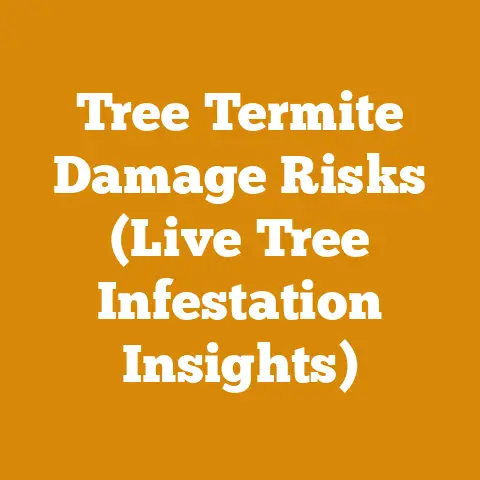Burn Stumps Effectively (Expert Tips for Safe Wood Processing)
As the days grow shorter and the air crisper, there’s a primal satisfaction in preparing for winter.
For many, that means stocking up on firewood.
But what about those stubborn tree stumps left behind after a tree comes down?
They can be an eyesore, a tripping hazard, and a breeding ground for pests.
Burning them seems like an obvious solution, but it’s not always straightforward.
I’ve spent years felling trees, processing wood, and dealing with the aftermath, and I’ve learned a thing or two about burning stumps effectively and safely.
This guide will provide expert tips to help you get the job done right, whether you’re a seasoned woodworker or just starting out.
Understanding the Challenge: Why Burning Stumps is Tricky
Burning stumps isn’t as simple as setting them on fire.
Several factors make it a unique challenge:
- Moisture Content: Stumps, especially those from recently felled trees, are saturated with moisture.
Green wood simply doesn’t burn as readily as seasoned wood. - Size and Density: Stumps are massive and dense.
The sheer volume of wood requires a significant amount of energy to ignite and sustain a fire. - Root System: The extensive root system anchors the stump firmly in the ground, preventing air circulation and hindering complete combustion.
- Soil Composition: The surrounding soil can also affect burning, especially if it’s damp or clay-rich.
This can smother the fire and slow down the process. - Safety Concerns: Uncontrolled fires are dangerous.
Burning stumps requires careful planning and monitoring to prevent accidents and environmental damage.
Key Concepts: Preparing for a Successful Burn
Before diving into the steps, let’s define some key concepts:
- Green Wood vs.
Seasoned Wood: Green wood is freshly cut and has a high moisture content (often above 50%).
Seasoned wood has been air-dried and has a lower moisture content (ideally below 20%).
Seasoned wood burns much more efficiently. - Combustion: The chemical process of burning, which requires fuel (wood), oxygen, and heat.
- Pyrolysis: The decomposition of organic matter by heat in the absence of oxygen.
This is the initial stage of burning, where wood breaks down into flammable gases. - Draft: The flow of air that supplies oxygen to the fire.
A good draft is essential for efficient burning. - Fire Triangle: The three elements needed for a fire: heat, fuel, and oxygen.
Removing any one of these elements will extinguish the fire.
Step-by-Step Guide to Burning Stumps Effectively
Now, let’s get into the practical steps.
I’ll share my experiences and insights along the way.
1. Assessment and Planning
- Inspect the Stump: Determine the size, species, and condition of the stump.
Is it freshly cut or has it been sitting for a while?
This will affect the moisture content and the approach you take. - Check Local Regulations: Before you even think about lighting a match, check your local regulations regarding open burning.
Many areas have restrictions or require permits, especially during dry seasons.
Ignorance is not an excuse, and fines can be hefty.
I once had to deal with a neighbor who thought he could burn debris anytime he wanted.
A visit from the fire department quickly changed his mind. - Consider Alternatives: Burning isn’t always the best option.
Consider alternatives like stump grinders, chemical stump removers, or simply letting the stump decompose naturally (which can take years).
Weigh the pros and cons of each method based on your situation. - Safety First: Identify potential hazards, such as nearby trees, buildings, power lines, or flammable materials.
Create a safe perimeter around the stump.
Have a water source (hose, buckets, etc.) readily available.
Wear appropriate safety gear, including eye protection, gloves, and sturdy boots. - Weather Conditions: Check the weather forecast.
Avoid burning on windy days or during dry spells.
Ideal conditions are calm winds and slightly damp ground.
2. Preparing the Stump
- Drilling Holes: This is crucial for promoting airflow and creating channels for the fire to spread.
Use a large drill bit (1-2 inches in diameter) to drill several holes deep into the stump.
Drill vertically and at an angle, aiming to create a network of interconnected tunnels.
The more holes, the better. - Seasoning the Stump (If Possible): If you have the time, let the stump dry out for several months.
This will significantly reduce the moisture content and make it much easier to burn.
You can speed up the drying process by covering the stump with a tarp to protect it from rain while still allowing air to circulate. - Adding Kindling and Fuel: Place dry kindling (small twigs, branches, wood shavings) around and inside the drilled holes.
You can also use commercially available fire starters.
Avoid using flammable liquids like gasoline, which can be dangerous and unpredictable.
I prefer using natural fire starters like pine cones dipped in wax or cotton balls soaked in petroleum jelly. - Creating a Chimney Effect: If the stump is tall enough, you can create a chimney effect by hollowing out the center.
This will improve airflow and draw the flames upwards.
Use an axe or chainsaw to carefully remove the wood from the center of the stump.
Be extremely cautious when using a chainsaw near the ground, as you could hit rocks or other debris.
3. Igniting the Fire
- Start Small: Don’t try to ignite the entire stump at once.
Start with a small fire in one or two of the drilled holes.
Gradually add more kindling and fuel as the fire grows. - Patience is Key: Burning a stump takes time.
It can take several hours or even days to completely burn a large stump.
Be patient and monitor the fire closely. - Maintain the Fire: Add fuel as needed to keep the fire burning steadily.
Use dry firewood or branches to feed the flames.
You can also use a metal poker to stir the embers and improve airflow. - Control the Fire: Keep the fire contained within the designated area.
Use a shovel or rake to clear away any flammable materials that could catch fire.
Have a water source readily available to extinguish any stray embers.
4. Monitoring and Extinguishing
- Never Leave the Fire Unattended: This is the most important safety rule.
Always monitor the fire closely and be prepared to extinguish it if necessary. - Check for Underground Roots: Fire can spread underground through the root system.
Periodically check the surrounding area for smoke or flames.
If you see any signs of fire spreading, immediately extinguish it with water. - Extinguishing the Fire: Once the stump has burned down to the ground, thoroughly soak the remaining embers with water.
Stir the ashes with a shovel to ensure that all the embers are extinguished.
Continue to monitor the area for several hours to ensure that the fire does not reignite. - Dispose of Ashes: Once the ashes are cool, you can dispose of them in a safe manner.
You can use them as fertilizer in your garden, but be sure to check the pH level first.
Tools and Equipment
Here’s a breakdown of the tools I typically use for burning stumps:
- Chainsaw: Essential for felling trees and preparing the stump.
I recommend a chainsaw with a bar length of at least 18 inches.
I personally use a Stihl MS 271 FARM BOSS® for most of my wood processing needs.
It’s a good balance of power and weight. - Axe: Useful for splitting wood and creating kindling.
A splitting axe with a heavy head is ideal for splitting large logs. - Drill: For drilling holes in the stump to promote airflow.
A heavy-duty drill with a 1-2 inch drill bit is recommended. - Shovel: For clearing away flammable materials and stirring the embers.
- Rake: For raking leaves and debris away from the fire.
- Water Source: A hose, buckets, or a fire extinguisher.
- Safety Gear: Eye protection, gloves, sturdy boots, and hearing protection (when using a chainsaw).
- Metal Poker: For stirring the embers and improving airflow.
Advanced Techniques and Considerations
- Using Potassium Nitrate (Stump Remover): Potassium nitrate is a chemical compound that accelerates the decomposition of wood.
You can purchase it at most garden supply stores.
To use it, drill several large holes in the stump and fill them with potassium nitrate.
Add water to moisten the powder.
Over time, the potassium nitrate will break down the wood, making it easier to burn or remove.
However, be aware that potassium nitrate can be harmful to the environment if not used properly.
Follow the manufacturer’s instructions carefully. - The “Top-Down” Burning Method: This method involves building a fire on top of the stump and allowing it to burn downwards.
This can be effective for large stumps, as it allows the fire to gradually consume the wood.
To do this, build a platform of firewood on top of the stump.
Ignite the platform and let it burn downwards.
Add more firewood as needed. - Using a Burn Barrel: If you’re concerned about controlling the fire, you can use a burn barrel.
A burn barrel is a metal container that contains the fire and prevents it from spreading.
To use a burn barrel, place the stump inside the barrel and ignite it.
Be sure to monitor the fire closely and add fuel as needed. - Dealing with Wet Stumps: If the stump is very wet, it may be difficult to ignite.
You can try using a propane torch to preheat the stump before lighting the fire.
You can also use a commercial fire starter that is designed for wet wood. - Environmental Considerations: Be mindful of the environmental impact of burning stumps.
Smoke can pollute the air and contribute to climate change.
Consider alternatives to burning, such as stump grinding or chemical stump removal.
If you do choose to burn, do so responsibly and in accordance with local regulations.
Case Study: Burning a Large Oak Stump
I once had to deal with a massive oak stump that was left behind after a tree was felled on a client’s property.
The stump was about 4 feet in diameter and 3 feet tall.
It was also very wet, as the tree had been felled just a few weeks prior.
I started by drilling numerous holes in the stump, using a 1-inch drill bit.
I drilled both vertically and at an angle, creating a network of interconnected tunnels.
Next, I placed dry kindling and fire starters in the holes.
I used a combination of pine cones dipped in wax and cotton balls soaked in petroleum jelly.
I ignited the kindling and waited patiently for the fire to grow.
It took several hours for the fire to really take hold.
As the fire burned, I added more firewood to keep it going.
I used a combination of dry oak and maple.
I also used a metal poker to stir the embers and improve airflow.
After about two days of continuous burning, the stump had burned down to the ground.
I thoroughly soaked the remaining embers with water and monitored the area for several hours to ensure that the fire did not reignite.
The entire process took a lot of time and effort, but it was ultimately successful.
The client was very happy with the results.
Cost Analysis
The cost of burning stumps depends on several factors, including the size of the stump, the amount of fuel required, and the cost of labor (if you hire someone to do it for you).
Here’s a rough estimate of the costs involved:
- Fuel: The cost of firewood or other fuel can vary depending on your location and the type of fuel you use.
Expect to spend anywhere from \$50 to \$200 on fuel for a large stump. - Fire Starters: The cost of fire starters can range from \$10 to \$30.
- Drill Bit: A 1-2 inch drill bit can cost anywhere from \$20 to \$50.
- Labor: If you hire someone to burn the stump for you, expect to pay anywhere from \$100 to \$500, depending on the size of the stump and the complexity of the job.
Overall, the cost of burning a stump can range from \$80 to \$780.
Safety Precautions: A Non-Negotiable Aspect
I can’t stress enough the importance of safety when dealing with fire.
Here’s a recap of the key safety precautions:
- Check Local Regulations: Always check your local regulations regarding open burning before you start.
- Create a Safe Perimeter: Clear away any flammable materials from the area around the stump.
- Have a Water Source Readily Available: Keep a hose, buckets, or a fire extinguisher nearby.
- Wear Appropriate Safety Gear: Eye protection, gloves, sturdy boots, and hearing protection (when using a chainsaw).
- Never Leave the Fire Unattended: Always monitor the fire closely.
- Check for Underground Roots: Be aware that fire can spread underground through the root system.
- Extinguish the Fire Thoroughly: Once the stump has burned down, thoroughly soak the remaining embers with water.
- Be Mindful of the Environmental Impact: Smoke can pollute the air.
Consider alternatives to burning.
Strategic Advantages of Burning Stumps
While it requires effort, burning stumps offers certain advantages:
Burning stumps is a challenging but rewarding task.
With careful planning, preparation, and execution, you can safely and effectively remove those unwanted stumps and reclaim your land.
And as you stand back and watch the flames consume the wood, you can take pride in knowing that you’ve done it yourself.
Remember, I’m here to help.
If you have any questions or need further guidance, don’t hesitate to reach out.
Happy burning (safely, of course)!






